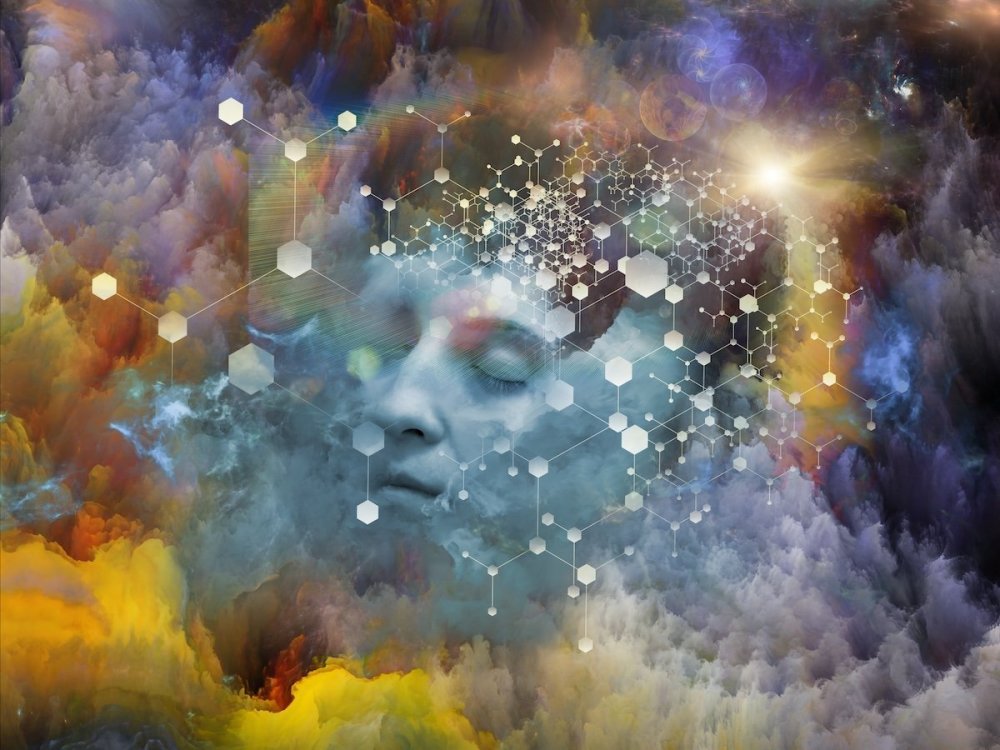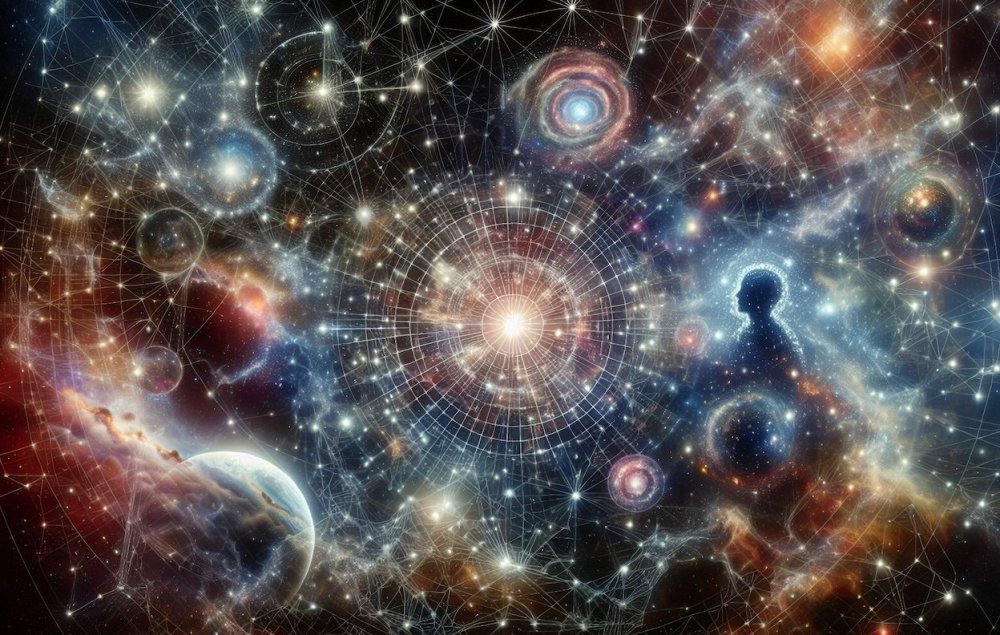Put simply, nonduality (or nondualism) is a way of being whereby you feel interconnectedness with everyone and everything around you. Rachel Markowitz explains the deeper meaning of nonduality, its origins within Hinduism and Buddhism, and ways you can practice it.
Take a moment to consider how you interact with the world – not only your physical surroundings, but also how you see yourself and others. Do you envision yourself as an individual? Are you part of a whole? Can you imagine your life as something entirely beyond these concepts?
As it turns out, it’s rare to see “self” as something other than a person; that is, as an individual who wanders through life, engages with others, and strives for the ideals of health, true connection, and a sense of purpose.
However, at some point along the spiritual path, we tend to encounter profound questions about the nature of self, the universe, and reality. When contemplating these questions, it’s helpful to understand the meaning of nonduality – the direct experience of “not two.”
 In nondualism, the nature of Self is pure awareness or consciousness
In nondualism, the nature of Self is pure awareness or consciousness
If you find this concept hard to grasp, pause and reflect for a moment on this enlightening quote from British-American writer and philosopher Alan Watts: “You are a function of what the whole universe is doing in the same way that a wave is a function of what the whole ocean is doing.”
To hopefully make the concept clearer, this article will provide an introduction to nondualism, explain nonduality vs. duality through ancient yet still-relevant teachings, and suggest methods for opening to nondual awareness.
What is Nonduality?
Nonduality comes from the Sanskrit word advaita, which translates to “not two.” Thus, nondualism conjures ideas like oneness, completeness, and infinity.
However, nonduality is more than a concept or philosophy; it’s an experiential recognition, and because of this, it can’t be taught or captured within the limits of language. Accordingly, most teachings explain nondualism by what it is not: nonduality (advaita) is the absence of duality (dvaita). Therefore, to understand nonduality, it’s essential to first discuss duality.
What is Duality?
In simple terms, duality implies two opposing forces. In a dual existence, we consider aspects of life as good or bad, light or dark, positive or negative, and so on. Regardless of whether these forces are seen to negate or complement each other, they are two ends of a spectrum that are separate.
“Nonduality comes from the Sanskrit word advaita, which translates to “not two.” Thus, nondualism conjures ideas like oneness, completeness, and infinity.”
When we look at existential questions, duality often refers to the idea that we (humans) are separate from God (which we could also call existence, the universe, the divine, etc.) In dualism, I am a human, you are a different human, and there is a God apart from you and me. I am a subject perceiving objects, and I see the world through the unique eyes of a unique seer who is uniquely seeing.
Nonduality vs Duality
On the other hand, in a state of nondual awareness, there is no separation between an individual and God (existence, universe, etc.) In other words, nonduality implies that subject and object are of the same nature, and that there is no difference between the seer, the seeing, and what is seen. From a nondual perspective, pairs of opposites are perceived as manifestations of the absolute.
Since this may feel like a stretch to the rational mind, it’s important to note that when we look at nonduality versus duality, nondualism isn’t anti-dualism. Nondualism is simply a way of existing that is not based in separation. However, through this nondual lens, we can still recognize opposing forces and see that, from a human perspective, duality exists.
Nondual Teachings
History has pointed towards nondual awareness as part of various philosophical and spiritual traditions throughout space and time. Although we can see examples of nonduality suggested in lineages of shamanism, Taoism, Sufism, and even Christianity, this state is most succinctly illustrated through the ancient Indian and Buddhist philosophies that have shaped contemporary nondual teachings.
 Nonduality is the human experience of oneness; a sense of connectedness and identity
Nonduality is the human experience of oneness; a sense of connectedness and identity
Advaita Vedanta
According to Advaita Vedanta (nondualism as taught in the Vedas, the oldest texts of Hinduism), everything is Brahman, the absolute, and the true Self (or Atman) is not separate from Brahman. Put simply, the nature of Self is pure awareness or consciousness. The catch is that we only know this to be true when we experience life in nondual awareness.
To illustrate this concept, Advaita teachings often use a metaphor involving a cinema to give an example of nonduality. When we watch the movie of our lives, we often think we are the main character. However, in reality, we are not limited to a character or to the one watching the film. Rather, we are the blank screen upon which everything is happening. And, as an observer, we can see that nothing on the screen can affect the screen itself.
Nonduality in Buddhism
Although Buddhism negates the idea of a true, inherently existing Self or Atman, the teachings of the Buddha are also nondual. In fact, in Buddhism, the belief in a separate self is known to be the source of all human suffering!
“When we look at nonduality versus duality, nondualism isn’t anti-dualism. Nondualism is simply a way of existing that is not based in separation.”
In Buddhism, nonduality is expressed as advaya, and concepts such as recognizing emptiness (sunyata), impermanence (annica), and no-self (anatta) all direct us towards the understanding of our “Buddha nature.”
The Buddha taught that what we see as reality is merely an illusion that can be overcome by anyone through disciplined practice or, as commonly taught in Zen traditions, through a sudden experience that causes one to forget the limited self.
RELATED:
Practicing Nondualism
The only way to completely “understand” nonduality is to directly recognize it. However, seekers of truth can intentionally make an effort to predispose themselves to practices and teachings that have the potential to open doors to nondual reality. So, if you’re curious about nonduality, consider these three suggestions:
1. Meditation
Although all meditation techniques will eventually lead to the same place, the following two concentration methods can directly facilitate states of pure awareness:
- Contemplating the Self
Examining the self, or “self-inquiry,” is asking yourself, “who am I?” The premise of this practice is that the ego, when directly targeted, can’t justify its existence. Thus, with repeated asking and searching, the Self is revealed.
- Contemplating Emptiness
Buddhist techniques like analytical meditation and witnessing the emptiness of the mind help us grasp the nature of reality – the interdependent, transient essence of existence.
2. Exploring the Teachings
As previously mentioned, nonduality is referenced through time-tested (and also timeless!) scriptures. These teachings hold energy and have the potential to transmit experience to those who read between (or beyond!) the lines. Here's a short list of Vedic and Buddhist teachings that point towards the true meaning of nonduality:
-
The foundational texts of Advaita Vedanta: the Upanishads, the Brahma Sutras, and the Bhagavad Gita, along with hundreds of commentaries and texts by 8th-century scholar and teacher Adi Shankaracharya.
-
Who Am I? by Sri Ramana Maharshi, a 20th-century sage with a large global following who spread interest in Advaita Vedanta through his teachings.
-
I am That by Nisargadatta Maharaj, another self-realized sage who followed the path of Ramana Maharshi.
-
The Heart Sutra, a Mahayana Buddhist text (translated here into modern-day language by Vietnamese Buddhist Monk Thich Nhat Hanh).
-
The Great Way, a poem by the third Patriarch of Zen, illustrating nonduality vs. duality.
3. Repeating Nondual Affirmations
Affirming or contemplating your true nature can also nudge your awareness into a space of nondualism. To practice, you can repeat one of the following affirmations or mantras, aloud or mentally:
- I Am
- Shivoham (literally, “I am Shiva”, which we can interpret as “I am consciousness.”)
- Tat Tvam Asi (One of the four Mahavakyas, or great truths from the Upanishads, that translates to “That Art Thou” or “You Are That,” in reference to our true essence)
Takeaway: What is Nonduality?
Seeing from a nondual perspective allows us to open to life’s mysteries. If this feels overwhelming, keep in mind that if you’re reading this, you’re already on your way; contemplating the meaning of nonduality and witnessing the mind, along with sincere introspection, can reveal to you the pure essence of “not two!” Let's finish with this quote from Indian Hindu sage Sri Ramana Maharshi: “In reality, there is neither dvaita or advaita, but that-which-is.” ●
Images: shutterstock/agsandrew, shutterstock/AI Generator
happiness.com | The fine art of being: learn, practise, share
Are you a happiness.com member? Sign up for free now to:
■ enjoy our happiness magazine with practical life tips
■ share and support others in our happiness forum
Acceptance | Letting go | Eckhart Tolle
Written by Rachel Markowitz
 Rachel recently found herself over a decade deep in a worldwide wander guided by what she feels to be true. She’s been facilitating classes and workshops on yoga, meditation, self-exploration, and alternative ways of living since 2012, mostly in Latin America and Asia. These days, she spends most of her time looking at, walking around, or singing to a sacred mountain in southern India. Read more of her words at her to those who wonder blog.
Rachel recently found herself over a decade deep in a worldwide wander guided by what she feels to be true. She’s been facilitating classes and workshops on yoga, meditation, self-exploration, and alternative ways of living since 2012, mostly in Latin America and Asia. These days, she spends most of her time looking at, walking around, or singing to a sacred mountain in southern India. Read more of her words at her to those who wonder blog.
Join the conversation
You are posting as a guest. If you have an account, sign in now to post with your account.
There are no comments to display.